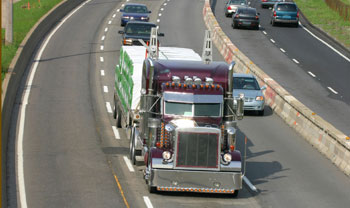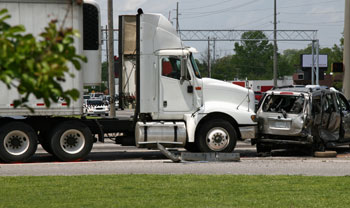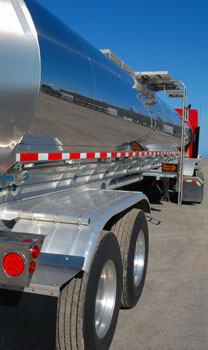Tips for Sharing the Road Safely with Big Trucks
With 11 million large trucks on the road, it’s no wonder that we often find ourselves frustrated, stuck behind a tractor-trailer that is blocking our vision or waiting for a semi-truck to make a tight turn.
The fact is, nearly 4,000 people were killed in large truck crashes last year and about 90,000 others were injured – significant increases over previous years’ statistics. In 2011, 287,000 large truck crashes were reported, and two-vehicle collisions involving trucks accounted for 80% of the deaths of passenger vehicle occupants.

We read and see on television news of horrendous truck crashes where the truck’s brakes failed or its overloaded cargo shifted, or the driver was texting or fell asleep. But Federal Motor Carrier Safety Administration (FMCSA) studies show that trucks and truck drivers are not always at fault. Recent truck accident causation studies say the blame for crashes is split about evenly between trucks/truckers and cars and their drivers . . . and as many as four out of five car-truck crash fatalities may have been caused by passenger car drivers.
You and your family members certainly don’t want to be included in any of these statistics. So in addition to continuing to exercise patience and practice safe driving, understanding why huge trucks behave differently from your car can save your life. Here are some things you need to know.
Cutting off a truck is a sure recipe for disaster. Even if you think your car can “stop on a dime,” a fully-loaded tractor trailer or semi-truck takes almost the length of two football fields to come to a full stop.
 While states have different regulations about size, semi-trucks generally are 8 feet 6 inches wide, 14 feet tall and from 45 feet (for a single vehicle) to 65 feet (for a tractor-trailer combination) long. The average gross weight is 80,000 pounds. Your car, in contrast, is about 6 feet wide, 5 feet tall (taller for SUVs), 12 to 15 feet long, and weighs from 3,000 to 4,000 pounds.
While states have different regulations about size, semi-trucks generally are 8 feet 6 inches wide, 14 feet tall and from 45 feet (for a single vehicle) to 65 feet (for a tractor-trailer combination) long. The average gross weight is 80,000 pounds. Your car, in contrast, is about 6 feet wide, 5 feet tall (taller for SUVs), 12 to 15 feet long, and weighs from 3,000 to 4,000 pounds.
Visualize a semi-truck and your car, side by side, in your mind and you get the picture: It’s going to take the truck a lot longer to stop.
- A passenger vehicle weighing from 3,000 to 4,000 pounds going 65 miles an hour will take 316 feet to stop, not quite the length of a 120-yard football field. A loaded semi-truck or tractor trailer weighing 80,000 pounds traveling 65 miles per hour takes 525 feet to stop, or just 195 feet short of the length of two football fields.
- Total stopping time is calculated not only by the distance traveled from the time the driver begins pressing the brake pedal, but takes into count perception distance – the time it takes to identify the hazard, consider what could happen, and decide to stop – plus the driver’s reaction time in executing the decision to stop.
- So when you are passing a truck, before you pull back over, you should leave at least one car length between you and the truck for every ten miles an hour you are driving. Let’s say you are passing at 65 miles per hour. That means you should wait until you are at least 6-1/2 car lengths past the truck before you merge back into the truck’s lane.
- In a five-year FMCSA study of trucks involved in rear-end crashes, which represent 18% of all multiple vehicle accidents, the truck struck the car 60% of the time. Every second of reaction time you can give the truck driver makes passing and merging safer. Some motor vehicle crash experts say that 90% of traffic accidents can be avoided when a driver has just one more second to react.
- Never assume, however, that the time and distance it takes for a large truck to stop means that, when you are behind the truck, you can follow closely and still have time to stop when the truck stops. According to FMCSA research, in 64% of fatal car-truck crashes, the car struck the truck. One reason is that when a car rear-ends a big rig, the truck’s underride guards may fail to keep the car from sliding underneath. When that happens, the car’s windshield becomes the point of impact and the top of occupants’ space is crushed, causing decapitation and death.
Because of their height and weight, big trucks have huge blind spots that create “No Zones” that other vehicles should stay out of. There are four main areas to avoid.
When you look up at a semi-truck, you can see mirrors all around – mirrors as tall as 25 inches, much larger than your puny side-view wing mirrors. But this doesn’t mean that the truck driver can see you all the time. A good rule of thumb is, if you can see the driver’s face in his or her side mirror, then that driver can see you too. Otherwise, you may be driving in a blind spot.

- A truck driver has blind spots on the side of the rig, one on each side, toward the front and then angling out. If you get caught driving in these “No Zones,” you easily could be sideswiped. You should slow down or move ahead to where you can be seen, especially if you are planning to pass.
- Trucks don’t have rear-view mirrors, so truck drivers have to rely solely on what they see through their side mirrors. At the rear of the truck, the driver’s blind spot extends nearly 200 feet from the back of the truck. So stay out of this “No Zone” – which also blocks your view, makes you reliant on the truck’s brake lights to anticipate it stopping, and increases your chances of rear-ending the truck. In short, tailgating a truck is a really dumb idea!
- A truck’s front blind spot or “No Zone” extends about 20 feet in front of the truck. If your car is 12 to 15 feet long, this means that for more than two car lengths, the truck driver can’t see you. So you can understand why, when you are passing a big rig at 65 miles an hour and then merging back into its lane, you should make sure there are at least 6-1/2 car lengths between you and the truck before you merge in front of it.
Another potential danger of sharing the road with big trucks is their wider turning radius, which means they often must use adjoining lanes before making and completing a turn.
On a downtown or neighborhood street, you may have been stuck in a line of traffic waiting for a big truck ahead to make a tight turn. Some two-lane roads and central city streets prohibit big rigs, but in most cases, truck drivers have a right to get where they need to go to deliver the goods they are carrying. The problem is, they take up so much room to maneuver!
- Large trucks have a wider turning radius than a passenger car because of their greater lengths – as you will recall, about five times longer than your vehicle. In order to avoid hitting the curb or jumping the curb and driving on the sidewalk, a truck must swing wide to the left in order to turn right and wide to the right in order to turn left.
- A big truck’s height also contributes to its turning challenges, especially in making a sharp turn to enter a narrow cross street (as opposed to entering an on- or off-ramp to access a highway). Because of the truck’s height of up to 14 feet, the truck’s center of gravity is much higher than that of your car or SUV, which increases the truck’s risk of tipping over.
- When you are behind a turning semi-truck, resist the temptation to go around it. Be alert to a truck’s turn signal so you will know which direction the driver is turning. If you are sure that the truck is turning right, it may be safe to pass it on the left. But never pass on the right, and don’t get squeezed in the “No Zone” when a truck is swinging wide in order to make its turn.
For drivers of passenger cars and other small vehicles, the lessons of truck safety boil down to two simple reminders:
- Respect a truck’s size and performance differences that may require greater vigilance on your part; and
- When you sense danger, stay out of the way . . . because truck versus car is never a fair fight.
Share This


